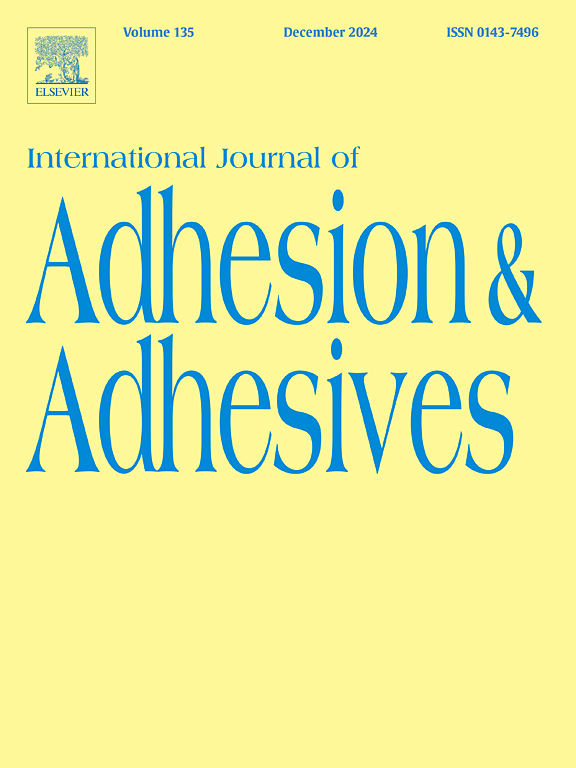Comparison of the microtensile bond strength of direct and indirect resin restorations in the cervical region
IF 3.2
3区 材料科学
Q2 ENGINEERING, CHEMICAL
International Journal of Adhesion and Adhesives
Pub Date : 2024-10-20
DOI:10.1016/j.ijadhadh.2024.103863
引用次数: 0
Abstract
Objectives
To evaluate in vitro the adhesion system of direct and indirect composite resin restorations in enamel and dentin, in cavities made in the cervical region using microtensile bond strength (μTBS) and to observe the most recurrent types of failure in the different groups.
Methods
Standardized cavities were made in the line of the cementoenamel junction (CEJ) in 36 selected human premolars, which were randomly divided into 2 groups. In the Indirect Restorations (IR) group, indirect restorations were cemented in composite resin, using a universal adhesive and dual resin cement, performing selective enamel etching (SEE). In the Direct Restorations (DR) group, direct restorations were made in composite resin, performing SEE and bonding with the universal adhesive. Each specimen was sliced into sections measuring approximately 1 mm2, with enamel and dentin adhesion divided into subgroups DRe, DRd, IRe, and IRd. The sections were subjected to the μTBS test to assess bond strength in both enamel and dentin, comparing direct and indirect restorations in the cervical region. The types of failure in each group were also observed.
Results
There was no statistically significant difference in μTBS between the DRe and IRe groups (p = 0.314) and also between the DRd and IRd groups (p = 0.145). There was a predominance of adhesive failures.
Conclusions
The bond strength of composite resin restorations was found to be equivalent in enamel and dentin, whether applied directly or indirectly. There was a predominance of adhesive fractures followed by cohesive resin fractures.
Clinical significance
The choice between direct and indirect restorations in the cervical region may consider patient preferences, but with caution, as clinical factors such as operator skill, specific tooth conditions and case complexity are crucial, and both techniques exhibit comparable bond strength.
颈椎区直接和间接树脂修复体的微拉伸粘接强度比较
目的 在体外使用微拉伸粘接强度(μTBS)评估直接和间接复合树脂修复体在牙颈部龋洞中与牙釉质和牙本质的粘接系统,并观察不同组别中最常出现的失败类型。方法 在选定的 36 颗人类前臼齿的牙釉质连接线(CEJ)上制作标准化龋洞,并将其随机分为两组。在间接修复(IR)组中,使用通用粘合剂和双树脂粘合剂粘结复合树脂间接修复体,并进行选择性釉质蚀刻(SEE)。在直接修复(DR)组中,用复合树脂制作直接修复体,进行选择性釉质蚀刻(SEE)并用通用粘合剂粘接。每个试样被切成约 1 平方毫米的切片,釉质和牙本质粘附分为 DRe、DRd、IRe 和 IRd 子组。对切片进行μTBS测试,以评估牙釉质和牙本质的粘接强度,并对颈部的直接修复体和间接修复体进行比较。结果DRe组和IRe组之间的μTBS差异无统计学意义(p = 0.314),DRd组和IRd组之间的差异也无统计学意义(p = 0.145)。结论复合树脂修复体的粘接强度在釉质和牙本质中是相同的,无论是直接粘接还是间接粘接。临床意义在牙颈部选择直接修复还是间接修复可以考虑患者的偏好,但要慎重,因为操作者的技能、特定的牙齿条件和病例的复杂性等临床因素至关重要,这两种技术的粘接强度相当。
本文章由计算机程序翻译,如有差异,请以英文原文为准。
求助全文
约1分钟内获得全文
求助全文
来源期刊

International Journal of Adhesion and Adhesives
工程技术-材料科学:综合
CiteScore
6.90
自引率
8.80%
发文量
200
审稿时长
8.3 months
期刊介绍:
The International Journal of Adhesion and Adhesives draws together the many aspects of the science and technology of adhesive materials, from fundamental research and development work to industrial applications. Subject areas covered include: interfacial interactions, surface chemistry, methods of testing, accumulation of test data on physical and mechanical properties, environmental effects, new adhesive materials, sealants, design of bonded joints, and manufacturing technology.
 求助内容:
求助内容: 应助结果提醒方式:
应助结果提醒方式:


